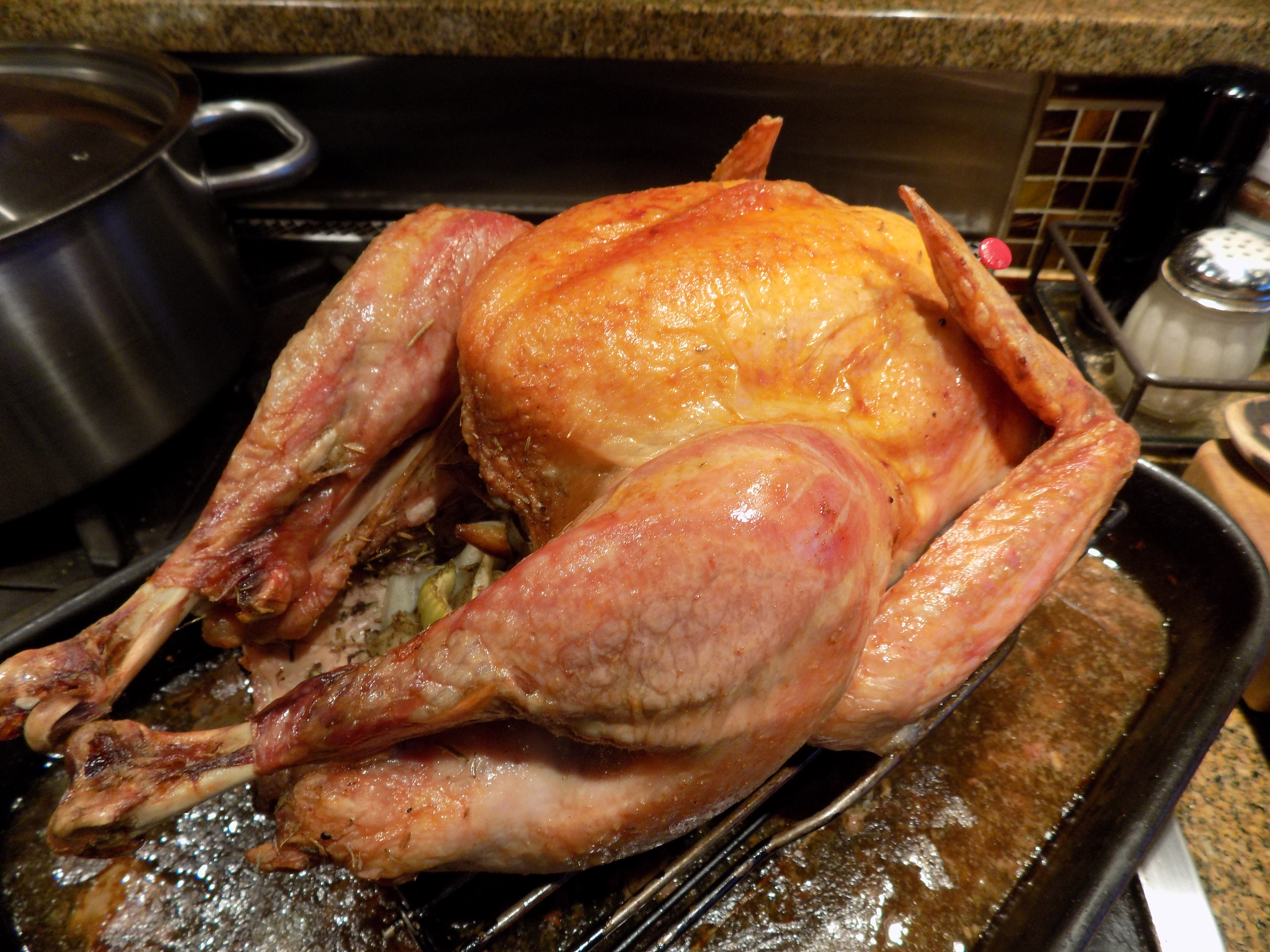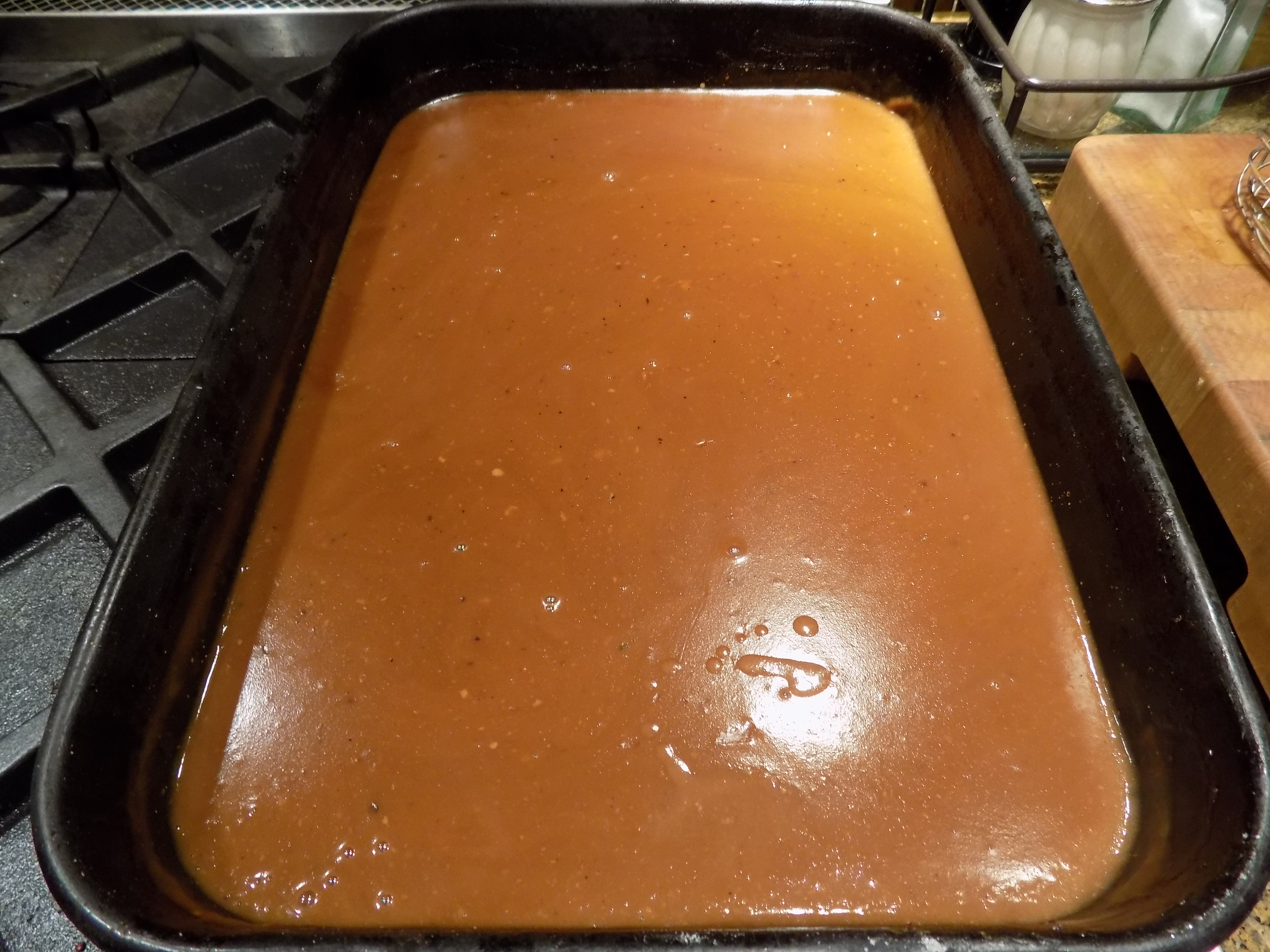OK, you got to know that I have roasted a lot of turkeys in my day. From my first days of roasting turkeys until about 15 years ago I baked my Thanksgiving and Christmas turkeys in a brown paper bag. Many a great turkey was roasted this way, by-the-way. (I even tried this method one year at our cabin. Suffice it to say that it is not a good idea to use a brown PAPER bag in the oven of a wood burning stove! Duh!) But that’s a story for another time…………
Then a few years ago brining turkeys became the rage. And of course I had to give that method a try. And yes indeed, brining a turkey creates a flavorful, tender and succulent bird. Absolutely no doubt about it. And that’s how I prepared my turkeys for the next several years. But brining a turkey is a pain in the bucket. So when I found this recipe in the November 2008 issue of Bon Appétit, I decided what the heck, if it’s good enough for Bon Appétit, it should be good enough for me and mine!
Well boy howdy, I about flipped when I tasted the melt-in-your-mouth meat. And the gravy! Now I pride myself on being able to make good gravy (my friend Jim says it’s because of the grandma gene), but my old standby recipe went into overdrive when I used the juices and fat from the herb salted bird. It simply was the best turkey gravy I had ever prepared, let alone tasted!
And salting a bird, rather than surrounding it in brine is so very easy. And the effect is the same – juicy, flavorful meat. Can you ask for more than that? Well yes you can. Gravy from heaven! And I am here to help you with just that very thing.
So fasten your seat belts and prepare to read about making sensational and easy turkey and gravy for your family and friends. And if you decide to give it a try, I am confident you will not be disappointed. Happy Thanksgiving.
Herbed Salt Ingredients:
- 1/3 c. + 1 T. kosher salt
- 1 ½ tsp. dried rosemary
- 1 ½ tsp. dried sage
- 1 ½ tsp. dried thyme
- 1 tsp. black peppercorns, crushed
- 3 bay leaves, coarsely chopped
- 1 lemon
Turkey Ingredients:
- 14-16 lb. fresh turkey (there really is a difference)
- 1 lg. onion, chopped
- 1 celery stalk, chopped
- 1 tsp. dried rosemary
- 1 tsp. dried sage
- 1 tsp. dried thyme
- ½ c. melted butter
- 2 c. chicken stock
- 3 c. turkey stock, or more if needed (recipe below)
Turkey Stock Ingredients:
- 1 turkey drumstick or 2 to 3 turkey thighs (get yours early and freeze, because it’s darn near impossible to find these just before Thanksgiving)
- reserved neck and giblets
- 2 qt. chicken stock
- 2 qt. water
- 1 onion, rough chopped
- 2 carrots, cut into large chunks
- 2 garlic cloves
- 3 stalks celery, cut into big chunks (don’t use the leaves – you want them for the dressing)
- 2 bay leaves
- 3 T. dried parsley
- 1 tsp. dried thyme
- 6 peppercorns
- 1 tsp. kosher salt
Herbed Salt Directions: Combine salt, rosemary, sage, thyme, peppercorns, bay leaves, and zest from lemon. (Chop the rest of the lemon and refrigerate until ready to bake the turkey.) Rinse the turkey but don’t pat dry. (Save the neck and giblets for the Turkey Stock you are going to make Thanksgiving morning.) Sprinkle herbed salt on the inside and outside of the turkey. Place in two small garbage bags, set inside a container and refrigerate 18-20 hours.
Roasting the Turkey Directions: Just before baking, wash the bird and pat dry. In a small bowl, combine the onion, celery, rosemary, sage, thyme, and reserved chopped lemon and stuff into the cavity of the bird. Place the turkey on a rack inside a large roasting pan. Slather with some of the butter. Pour 2 cups of chicken stock in the bottom of the pan and bake for 45 minutes in a pre-heated 325 degree oven. Baste the bird with more butter and add turkey stock (by this time you can use your own homemade stock) to the bottom of the pan. (The pan should not be allowed to go completely dry.) Continue basting the bird and adding stock to the pan every 30-45 minutes or so until the turkey thigh reaches an internal temperature of about 170 degrees. This should take about 4-4 ½ hours. (If the bird gets too brown after a couple of hours, cover with aluminum foil for the remainder of the baking time.) Carefully remove the turkey from oven when done, remove to a platter, cover with aluminum foil, and allow to cool at least 45 minutes before slicing. Make gravy (see below) while the bird is resting.
Turkey Stock Directions: If you have a second oven, or make your stock ahead of time, spread the turkey parts out on a rimmed baking pan. Bake in a 400 degree oven for 1 hour or until the meat is well browned. (If you don’t have a 2nd oven, place the raw turkey parts in the bottom of a large soup pot.) When the bones are out of the oven, place them in the bottom of a large soup pot. Pour a little water onto the baking pan, and allow to sit and cool for a few minutes. Then carefully pour the water and as much of the brown stuff that was stuck to the bottom of the pan on top of the meat. Add all the remaining ingredients, bring to a boil, reduce heat, cover pan and let simmer gently while your turkey bakes. Use as needed for baking the turkey. Use remaining turkey stock for gravy.
TURKEY COGNAC GRAVY:
All is fair when it comes to making gravy. And truly great gravy starts with the pan drippings left in the bottom of the roasting pan after the turkey has been removed to cool. (And yes, we are talking cholesterol city here, but once or twice a year, leave your worries behind and travel to the dark side!)
- pan drippings from roasted turkey
- flour
- turkey or chicken stock
- 2 tsp. Kitchen Bouquet
- freshly ground black pepper
- 2-3 turkey gravy mixes (just in case)
- 2-3 tsp. cognac
Place the roasting pan on the stove after the turkey has been removed. Turn the heat to very low and begin making your gravy immediately. (Good gravy flavor and consistency require time to develop.) Do not remove any fat from the pan, do not strain the liquid, do not do any of the things most cook book writers tell you to do to make good gravy (except me, that is!).
Whisk in enough flour to absorb the fat. Let burble for a couple of minutes. (This process takes time, so be patient.) Slowly whisk in turkey or chicken stock until the gravy reaches the desired thickness you like. Add the Kitchen Bouquet (gives the gravy great color) and some freshly ground black pepper. No salt! Taste the gravy. If you think it needs more depth of flavor, begin by adding one of the gravy mixes and a small amount of turkey stock. Let it simmer for a couple of minutes and taste again. Repeat if needed.
Turn heat as low as possible and let the gravy simmer away for the next 30 minutes or so, whisking periodically. (You will probably need to add more stock during this time.) Also, after the turkey is sliced and plated, don’t forget to add the juices that have accumulated to the gravy.
Just before serving (and gravy should be the last item plated), taste the gravy and make any final adjustments to the seasoning. Stir in the cognac and serve piping hot.
Note: if the gravy seems a little salty, you might try adding a teaspoon or two of fresh lemon juice.


